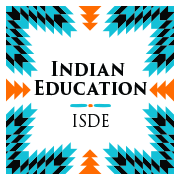
The Indian Education department at the Idaho Department of Education works with Idaho’s tribes and educational stakeholders to give every American Indian student the opportunity to learn and achieve academic success. Our mission is to maintain the unique status of American Indians, preserve their cultural identity, and raise cultural awareness.
Indian Education Goals:
- Increase communication among the Idaho Department of Education, Local Education Agencies (LEAs), and Tribal Education Agencies (TEAs) regarding policies, procedures, and financial regulations for American Indian education.
- Assist in removing educational barriers for the American Indian population.
- Expand best practices in teacher preparation and professional development that support American Indian students.
- Continue activities that strengthen the relationships and advance communication between the Idaho Department of Education, American Indian Tribes, State Board of Education, and colleges and universities.
- Provide timely and relevant information on American Indian education through technical assistance, guidance, and support to Idaho's educators, schools, districts, students, parents, business leaders, and the community.
Vision: The Indian Education department is committed to increasing equitable educational opportunities, relevant learning environments, and high-quality teaching to create learning atmospheres where all American Indian students achieve educational success.
Johnson O'Malley (JOM) Program
Johnson O'Malley (JOM) is a federally-funded program that provides supplemental education programs for American Indian students attending public schools. The Idaho Department of Education receives the funds from the federal government and in turn contracts with the public schools within the Nez Perce Tribal boundaries. Schools receive funds based on the number of American Indian students attending each school. The program(s) are overseen by a committee elected from the parents of American Indian students enrolled in the school district. The parent committees are active in the planning and implementing of the JOM program.
In 1934, Hiram W. Johnson, Chairman of the Senate Committee on Indian Affairs, introduced Bill S2571. Thomas P. O'Malley served as Chairman of the House Committee on Indian Affairs. The JOM Act was passed on April 16, 1934. The JOM Act provided the Secretary of the Interior with the authority to arrange with the states or territories for the education, medical attention, agricultural assistance, and relief of distress and social welfare of the Indians.
The Idaho Department of Education serves as the contracting agent with the Bureau of Indian Affairs (BIA) for the Johnson O'Malley (JOM) program. Although funding is based on total Indian student count in the district, most supplemental programs serve only a portion of their Indian enrollment. The count is composed of students having a minimum of a quarter (1/4) Indian blood or verified tribal enrollment. The Idaho Department of Education calls for a December 1st student count and student listing. Districts file a JOM Education Plan with the Idaho Department of Education.
The BIA determines a state amount based on the level of funding nationally. At the Idaho Department of Education level, a small amount is retained for administration and the remaining amount is divided by the total number of Indian students counted and submitted to the Idaho Department of Education to determine a per student amount. During recent years this rate has been in the $80.00 to $90.00 per student range. For a school district to receive JOM funding, the Indian Education Committee set the minimum number of students to be served by the school district at ten (10).
The major goals of the JOM program are to ensure that Indian students are functioning at grade level, that they remain in school through high school graduation, and that they have awareness and pride in their cultural heritage. Most districts combine their JOM funds with Title IX Indian Education grants from the U.S. Department of Education. Both of these programs require a parent committee and both are supplemental. The same parent committee can serve both programs. Planning is done around both sources of funds. The JOM program has helped serve Indian students to better adjust in the public school setting.
HIGHLIGHTS

Resource Files
General Information
- AIAN Enrollment / Native Youth Count
- IKEEP Brochure
- Idaho at a Glance: American Indian Education
- Idaho Reservation Map
Curriculum
Frequently Asked Questions
General Program Questions
Johnson O'Malley (JOM) Program
References
Training Resources
Introduction to Indian Education in Idaho
Resource Links
Rules and Laws
History
Idaho Bureau of Indian Education (BIE) Schools
Idaho Tribe Websites
- Coeur d' Alene Tribe
- Kootenai Tribe of Idaho
- Nez Perce Tribe
- Shoshone-Bannock Tribes
- Shoshone-Paiute Tribes
Johnson O’Malley Links
Tribal Government
National Websites
- Bureau of Indian Affairs
- Bureau of Indian Education (BIE)
- National Congress of American Indians
- National Indian Child Welfare Association
- National Museum of the American Indian (NMAI)
- Native Knowledge 360°
- Northwest Portland Area Indian Health Board
- U.S. Department of Education Office of Indian Education